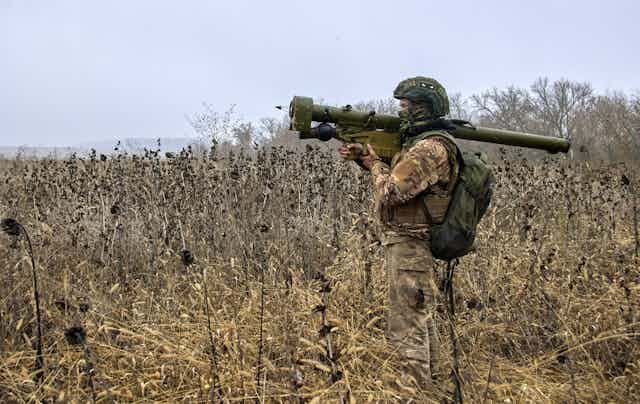For the first time since Russia invaded Ukraine in February, the war has come close to spilling across the border in a Nato country. On the evening of Tuesday November 15, a Russian-made missile landed in a village in Poland, killing two farmers. This was the nightmare scenario that Nato members had been fearing for some time.
After some confusion about who had launched the missile, it is now generally thought to have been fired by Ukrainian defence forces trying to target an incoming Russian missile. Nato’s secretary general, Jens Stoltenberg, said this did not absolve Russia of the blame for the incident.
“ Let me be clear: This is not Ukraine’s fault,” Stoltenberg told journalists. “Russia bears ultimate responsibility as it continues its illegal war against Ukraine.”
It was suggested that Poland might invoke article 4 of the Nato Treaty which calls for urgent consultations in situations when a Nato country is threatened. So far it has not done so.
Whether or not it turns out that this was an accident by Ukraine or deliberate act of aggression by Russia, there is a clear sense that Nato needs to send a strong signal to Russia not to escalate the conflict into any of its members’ territory as well as the need to show increased resolve to support Ukraine. The obvious risk is that unless there is a determined response, it could signal to Russia that it can get away with even deliberate strikes on the supply line from Poland to Ukraine which allows Kyiv to arm itself.
But any Nato response would need to be carefully calibrated to ensure it cannot be perceived as acts of direct military aggression against Russia. Possible options include deploying additional contingents of Nato troops to Poland and other frontline states as a warning of what might be in store were Russia to threaten to escalate beyond Ukraine’s borders.
What are Nato’s options?
The influential US-based thinktank, the Carnegie Endowment for International Peace, has suggested that talks about establishing a no-fly zone could be revitalised. This idea was rejected by Nato early on in the war, as it was thought that the use of aircraft from Nato countries to patrol the skies over all of Ukraine would pose too much of a risk of direct armed confrontation with Russian aircraft. But analysts at Carnegie now believe that Nato air patrols over border regions might now be considered to deter Russia from using combat aircraft over western Ukraine or straying into Nato airspace.
The least controversial option – and one most canvassed in the west – is for Nato countries to massively their supply of weapons systems to Ukraine. These should include short and medium-range air defence systems, including the US-built Raytheon national advanced surface-to-air missile systems (Nasams) as well as along with more advanced weapons such as the Lockheed Martin’s high-mobility artillery rocket system (Himars). Other long-range weapons, including Lockheed’s army tactical missile systems (ATACMS) would give Ukraine the ability to strike Russian targets at a range of about 300km (180 miles).

Meanwhile modern western-built tanks, jets and artillery would boost Ukraine’s ability to disrupt and cripple Russian offensives. Germany is still holding out on tanks as the chancellor, Olaf Scholz, has steadfastly rejected Kyiv’s requests to provide Leopard battle tanks or Marder infantry fighting vehicles, to avoid escalation of the conflict.
Ukraine’s foreign minister, Dmytro Kuleba, wasted no time in capitalising on the opportunity to make the case for increased western support. He said: “Ukraine reaffirms its full solidarity with Poland and stands ready to provide any necessary support. Collective response to Russian actions must be tough and principled”. He added that the possibility of an attack on Poland meant Ukraine should be supplied with “modern aircraft such as F-15 and F-16, as well as air defence systems, so that we can intercept any Russian missiles”.
Ukraine’s armed forces have been training on western military equipment. In July, the US Congress passed the National Defense Authorization Act. This has approved US$100 million (£85 million) in funding for military training, including training pilots to use A-10 Warthog planes, which are designed to destroy Russian tanks.
Ukraine’s changing shopping list
Despite much of the news from the battlefield centring on ground offensives, Ukraine’s air defence has been vital to its success in the war so far. Were Russia to gain unhindered mastery of the skies above Ukraine, it could use its large fleet of fixed-wing bomber and multi-role combat aircraft to strike military and civilian targets inside Ukraine at will.
But the success of Ukraine’s air defences in countering this threat – shooting down a significant number of Russia’s most sophisticated (and expensive) aircraft – has made the air war extremely expensive for Russia. And, given the strictly enforced sanctions, these sophisticated aircraft are proving very difficult to replace. As a result, Russia has virtually ceased such operations.
However, Ukraine needs to be resupplied with the portable missiles (or “manpads”) it has used so successfully against Russian air attacks. Russia’s use of hundreds of Iranian kamikaze drones to target its power supply have made this all the more urgent.
Thinktank the Royal United Services Institute (RUSI) has also identified an urgent need for “compact radar and/or laser ranging and sighting systems to allow numerous existing anti-aircraft guns to be much more accurate and effective” against systems like the Shahed-136. It warns that without swift and substantial rearming, Russia’s air force will “regain the ability to pose a major threat”.
So while the stray missile landing in Poland highlighted the perils of escalation in this war, it also represents an opportune reminder that Ukraine is the frontline in a war between Russia and the west. Western economies are facing rising fuel prices and inflation and support for massive aid packages to Ukraine may be softening in some quarters. The incident may encourage Nato and its allies to provide Ukraine with what it needs to continue to win the war against Russia.

